
The lack of budget is no longer an obstacle for startups, people in need often receive financial help online, and content creators can get monthly paid. Crowdfunding platforms made all of it possible. They changed the fintech industry, offering plenty of new opportunities for entrepreneurs, artistic souls, and just anyone who asks.
Are you dreaming of your own crowdfunding platform like Kickstarter or Patreon? Read about different ways to do it, must-have features, and cost to create a fundraising website. We’ll also tell you about the development challenges and best practices to overcome them.
The main principle of crowdfunding is raising small amounts of money from multiple people to generate a necessary budget for creative work, startups, community-oriented projects, medical treatment, etc.
Crowdfunding through the Internet originates in the 1990s when it began popular among music and art communities.
Today, there are numerous crowdfunding platforms in many countries, for example:
There are two categories of users on crowdfunding online platforms – those who ask for small donations and those who support projects or causes they find meaningful. Sometimes funders get rewards for regular installments, while other crowdfunding campaigns may be charitable.
Crowdfunding platforms usually charge from 5% to 13% of the money raised, plus processing fees.
Crowdfunding comes in all shapes and sizes, depending on why people ask for investments and how the system works. You’ll find several major types and examples of fundraising websites in the chart below.
| Type | Description | Example |
| Reward-based | Funders receive exclusive goods, content, or services for monthly contributions | Indiegogo, Kickstarter, Patreon |
| Donation-based | Fundraising for charitable causes like healthcare, community development, environmental, religious, and other social projects | GoFundMe |
| Equity-based | Many people become investors for a startup in return for a share of that business | Fundable |
| Peer-to-peer lending | People or businesses apply through secure platforms to lend money from others, sometimes offering valuable assets as collateral | Prosper, Zopa |
| Legal proceedings | Fundraising for plaintiffs or defendants in lawsuits | LexShares |
| Real estate | Raising funds for home buying, property redevelopment, and other commercial or residential projects | Fundrise, Realty Mogul |
| Agriculture | Attracting investments in agribusiness, farming and ranching | Harvest Returns |
| Scientific research | Raising funds for studies in various fields, from natural to social | Experiment |
Now let’s look closer at some famous examples and discover what makes specific crowdfunding platforms successful.
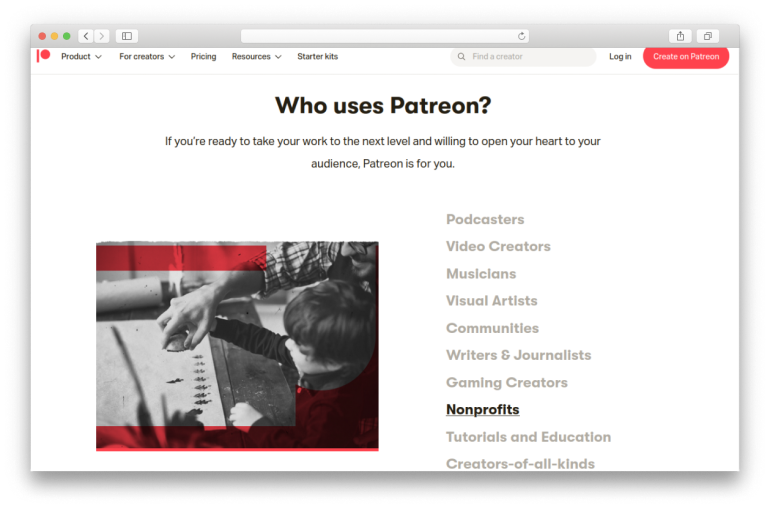
Categories of people and organizations that use Patreon
Initially intended for YouTube creators, Patreon is still highly popular among them. Alongside Video and Film, there are such categories as Games, Podcasts, Comics, Education, and Comedy.
The principle of Patreon’s work is patronage. Creators get paid monthly due to small donations from Patrons. This is a reward-based crowdfunding platform, meaning that Patrons receive extra content.
| Pros: | Cons: |
| ✚ great for creators with an existing fanbase; | ━ no advertising for new and less popular creators; |
| ✚ patrons receive valuable content; | ━ donors find it hard to discover new names. |
| ✚ save transactions via PayPal or bank cards. |
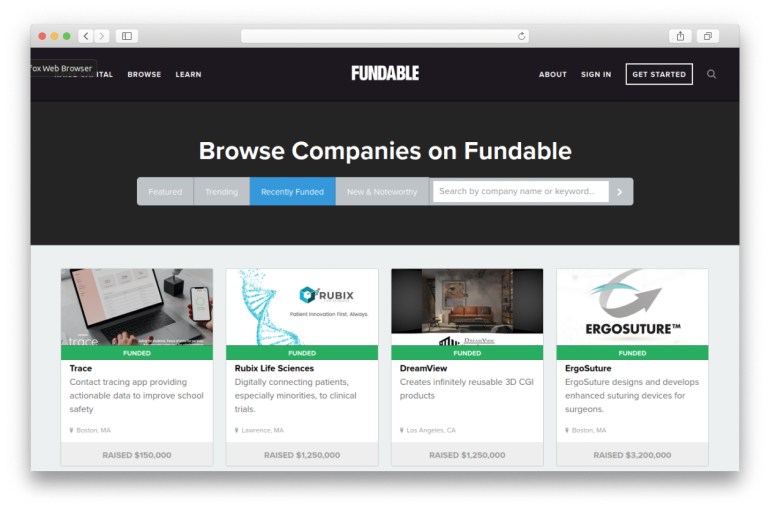
Categories of projects for crowdfunding on Kickstarter
Fundable is a crowdfunding platform for business projects. It helped lots of startups and entrepreneurs raise capital from investors. All the campaigns are divided into four categories: New & Noteworthy, Recently Funded, Trending, and Featured.
| Pros: | Cons: |
| ✚ funders can easily find new campaigns; | ━ limited time to raise funds; |
| ✚ both reward-based and equity-based crowdfunding; | ━ “all-or-nothing” funding |
| ✚ safety measures like campaign prescreening; | |
| ✚ good customer support; | |
| ✚ successful campaigns pay lower fees. |
The “all-or-nothing” system means a user gets nothing if their campaign doesn’t reach the funding goal. This helps protect founders but remains a disadvantage for campaign creators.
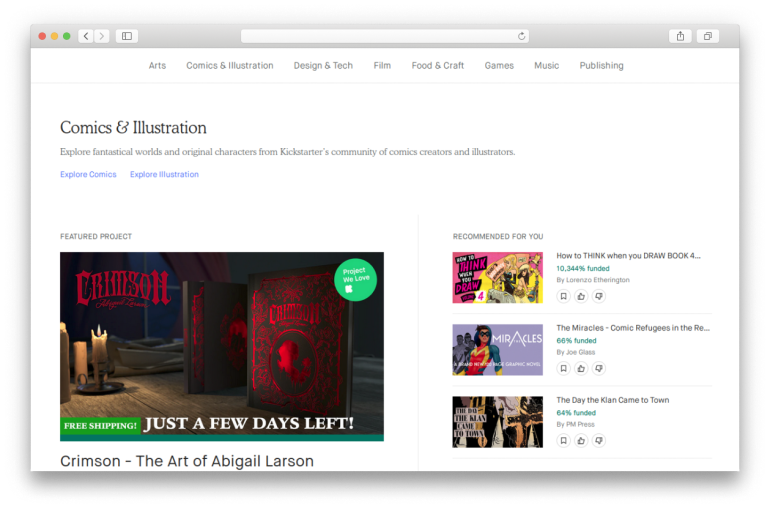
The "Comics & Illustration" category for crowdfunding on Kickstarter
Kickstarter is one of the oldest and renowned platforms in the crowdfunding market. It helps entrepreneurs with fundraising 13 categories and 36 subcategories, including Technology, Fashion, Art, Food, Comics, Theater, Photography, and many more. The most popular for crowdfunding are Music, Film/Video, and Games.
| Pros: | Cons: |
| ✚ easy to create your community; | ━ campaign creators have deadlines; |
| ✚ the subscription feature similar to Patreon; | ━ lack of customer support. |
| ✚ the “all-or-nothing” system protects funders. |
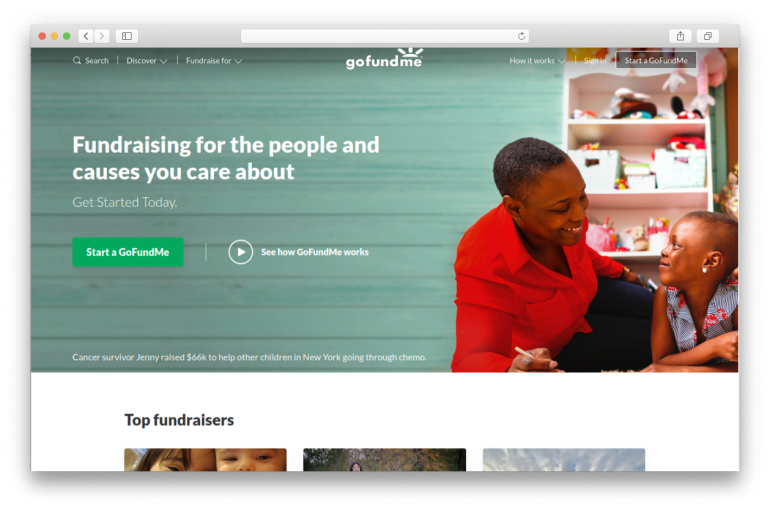
Main page on GoFundMe
GoFundMe allows individual users, charities, and different companies to fundraise money for different cases, from celebrations to lawsuits.
The platform became a leader in online fundraising for medical treatment – around 250,000 campaigns start every year and gather about $650 million in total.
The biggest advantage of GoFundMeis the absence of deadlines, which means a campaign continues after reaching its goal until a creator stops the crowdfunding process. However, campaign creators don't have advertising tools and should build communities by themselves, sharing their causes on social media, for example.
| Pros: | Cons: |
| ✚ very popular and recognizable; | ━ no advertising for campaigns; |
| ✚ free for personal campaigns across 10 countries; | ━ no anonymous donations; |
| ✚ donations are protected; | ━ funds are taxable in the US. |
| ✚ no deadlines. |
These crowdfunding platforms are popular in many countries. You can study their technical, marketing, and community-building experience to find the best practices and learn from the mistakes of others.
Suppose you have an idea of a crowdfunding website that will offer multiple opportunities and avoid unpopular features. What can go wrong? Here is a list of the widespread pitfalls based on the experiences of different platforms worldwide:
If you wish to overcome these challenges, you need to learn more about them. Let’s dive in.
Some businesses don’t succeed simply because they try to operate in the wrong niche of the crowdfunding market. This mistake makes it hard to attract the right audience and develop an efficient marketing strategy.
What can you do? Conduct market research and find the target group for your crowdfunding platform. Carefully choose the categories. It’s easier to build an online fundraising project around one or two niches, e.g., Games and Comics, or Personal issues and Nonprofit, etc. You can start with a narrow focus and then gradually add new categories as long as your platform becomes popular and attracts more investors.
“Before you even start building your crowdfunding page, start building a crowd first.”
— Roy Morejon, president and co-founder of Enventys Partners
Another crucial choice is a crowdfunding model – it should correspond with the niche. For example, a reward-based model is perfect for creative communities, while an equity-based one is suitable for entrepreneurs.
Remember, your platform’s safety will effectively work for its credibility because users want to be sure that their donations go to the right place.
There are specific laws and regulations for crowdfunding platforms, protecting from frauds and security bridges. As an owner of a new crowdfunding business, you should be compliant with AML laws (Anti Money Laundering) and KYC security standards (Know Your Customer), including verification of users’ identities and sources of funds, reporting on any suspicious activity, and other practices.
You should also secure your customers’ sensitive data – bank accounts, credit cards, etc.
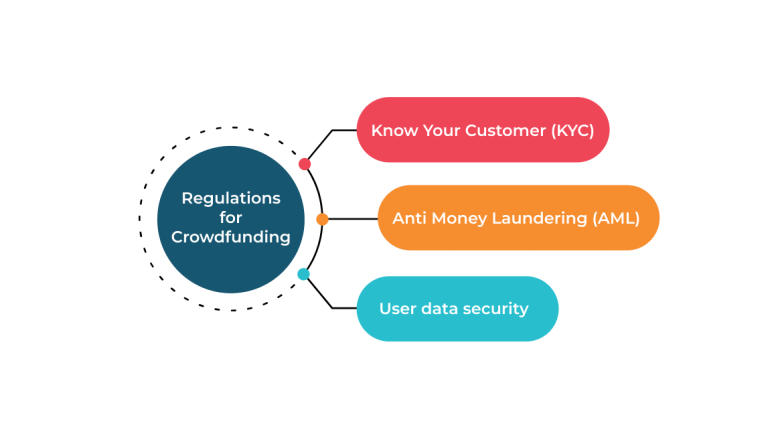
Any crowdfunding platform must be compliant with laws and regulations
Some regulations and laws differ from country to country.
For instance, the Securities Exchange Commission (SEC) in the United States demands registration in the system for all crowdfunding platform owners and limits the amount of annual investment from one person.
On the contrary, the Financial Conduct Authority (FCA) in the United Kingdom doesn’t require registration for crowdfunding platforms working within donation or reward models.
We advise you to study all guidelines on financial security in the country where you’re planning to start your crowdfunding business.
Another challenge for a crowdfunding startup owner is to select the right features that will suit both your niche and model. Here are some tips to help you decide.
For getting started:
For quick navigation:
For security and convenience:
Push notifications are also important on your crowdfunding website. You can use them to tell users about changes in campaigns they follow, new projects, platform updates, community news, etc.
There is also a specific set of features for the platform’s admins. It includes:
As you chose a business model and studied the governmental regulations, there is time to decide on design and development.
“You need to customize your crowdfunding site so it looks like your organization. This helps build trust and gets you more donations. ”
— Rob Wu, CEO and co-founder of CauseVox
There are three different approaches: custom, white-label, and open-source. All of them have specific pros and cons that you should consider, and the table below will help you with that.
| Open-source CMS like WordPress | “White label” (clone) solutions | Custom design & development | |
| Pros | Cheap – everything is made with templates and plugins, you simply adjust them to your business needs. | Fast – developers use functional modules to build a crowdfunding platform that looks better than a WordPress solution and can be quickly launched for users. |
Unique – a professional team works on every aspect of
your crowdfunding platform, from prototyping and design to
coding and quality testing. Flexible – during various development stages, you’ll get different versions of a product to present to potential users, collect feedback, and improve your crowdfunding platform accordingly. |
| Cons |
Limited – in some cases, you’ll have to hire a
developer to modify the ready-made code and implement specific
features. Security problems – crowdfunding platforms based on open-source CMS are easy targets for hackers. |
Inflexible – modules can’t be changed without additional coding, and you don’t choose the tech stack for development. | Expensive – you need more financial resources, compared to a clone solution or a WordPress-based platform. |
All in all, open-source CMS and “white label” designs will help you save money if you’re tight on budget and simply want to test the first version of your product in the real market. A custom solution is more suitable when you’re already sure about your idea and planning to build a unique crowdfunding platform.
How long will it take to build a website from scratch? How much does a crowdfunding platform cost? B2B rating sites collect and analyze prices for web and mobile development in different parts of the world. Let’s discover some examples.
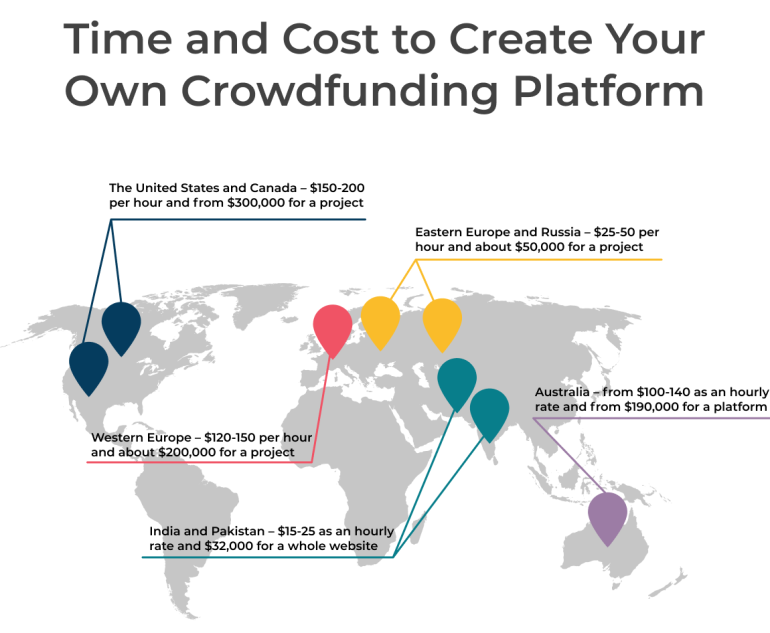
How much does it cost to create a crowdfunding website in different countries?
As you can see from the map, the prices for crowdfunding platforms in many cases depend not only on a project’s complexity but also on developers’ location.
How much does it cost to create your own unique and user-friendly crowdfunding platform with ADEV? We’ll give you several examples. Look at the chart to find out some approximate numbers.
| Stage or Feature | Technology | Time | Cost |
| UX/UI design | HTML, CSS, Figma, Adobe Creative Cloud | 160 hours | $4800 |
| Frontend development | Javascript, HTML, CSS, Angular | 600 hours | $18000 |
| Backend development | Node.JS, JavaScript, Go, Python | 600 hours | $18000 |
| Sign-in system | Email, SMS, social media | 60 hours | $1800 |
| Payment integration | PayPal | 80 hours | $2400 |
| Push notifications | Amazon SNS, Twilio | 40 hours | $1200 |
| QA tests and fixing problems | Selenium, Katalon Studio, TestComplete | 120 hours | $3600 |
All in all, creating a crowdfunding website with ADEV will cost you around $48,000 for a project of average complexity.
Depending on the business model, there are several monetization strategies for a crowdfunding platform. You can choose one or combine some of them.

When selecting a monetization model, think about both your business goals and potential users’ needs. They will be more likely to use your platform if it’s truly beneficial for them.
Crowdfunding platform development will bring you lots of challenges, and one of the most difficult ones is a choice of a trustworthy technology partner.
ADEV delivers top-tier services in web and app development across various industries. Are you ready to build a professional, smart-looking, user-friendly website for your crowdfunding business? Write to us if you wish to share your idea and learn more about how we work.
What is crowdfunding?
Crowdfunding is raising small amounts of money from multiple people to generate a necessary budget for some cause or project. The process is performed online via various digital platforms. Crowdfunding allows getting budgets for creative work, startups, community-oriented projects, medical treatment, etc.
What types of fundraising platforms are there?
According to the procedure, you can find four types of crowdfunding: Reward-based; Donation-based; Equity-based; Peer-to-peer lending. According to the industry, there are many types, including Legal proceedings; Real estate; Agriculture; Technology; Creative work; Scientific research, etc.
What technologies are used to create a crowdfunding platform?
UX/UI design is one of the priorities for such a platform. HTML, CSS, Figma, and Adobe Creative Cloud are used to make excellent user experience. Frontend development is performed with programming languages like Javascript or Angular. Backend development relies on Node.JS, JavaScript, Go, or Python. PayPal can be used as a payment gateway. For push notifications, developers usually apply Amazon SNS or Twilio.
How much does it cost to build a crowdfunding platform from scratch?
The prices for crowdfunding platforms depend on a project’s complexity and the developers’ location. Creating a crowdfunding website with ADEV will cost you around $48,000 for a project of average complexity.
How do I monetize my crowdfunding website?
There are several proven tactics: Paid membership; Featured section and advertising; Taking a percentage from raised funds or future sales; Borrowing or lending fees.

